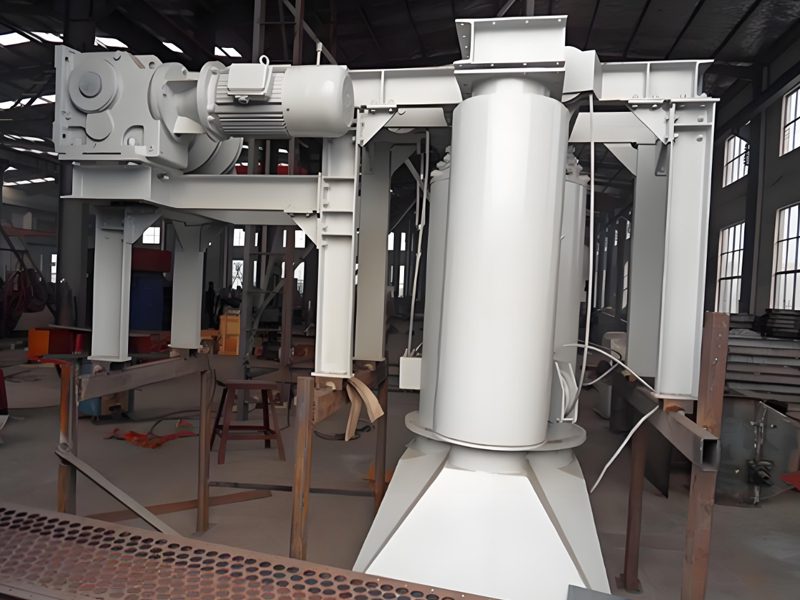In the vast, interconnected web of global industry, certain pieces of equipment operate quietly behind the scenes, bearing immense responsibility for the smooth flow of essential materials. One such critical, often overlooked component resides at the crucial juncture between cement production and global distribution: the لودر الكلنكر السائب. More than just a simple loading chute, this sophisticated system is the essential gatekeeper ensuring vast quantities of hot, abrasive clinker – the fundamental ingredient in cement – transition efficiently and safely from land storage onto seagoing vessels or barges for transport worldwide. This article delves deep into the world of clinker bulk loaders, exploring their design, functionality, critical components, technological advancements, and why they are indispensable in the modern cement supply chain.
Understanding the Significance: Why Loaders Matter
Clinker, produced by burning limestone, clay, and other materials in a kiln at temperatures exceeding 1400°C, is a nodular, grey, rock-like substance. It’s the primary intermediate product before grinding into cement powder. Its characteristics – extreme heat (when fresh), abrasiveness, dustiness, and free-flowing nature – pose unique challenges for handling, especially when loading hundreds or thousands of tonnes per hour into ships.
- Efficiency & Scale: Cement plants produce massive volumes of clinker daily. Loading this output into bulk carriers (Panamax to Capesize) quickly is paramount to avoid production bottlenecks and costly vessel demurrage charges. Loaders must achieve high throughput rates (often 1,000 – 2,500 tonnes per hour or more).
- حماية البيئة: Clinker dust is a significant environmental and occupational hazard. Loaders must incorporate robust dust suppression and containment systems to prevent widespread pollution and protect worker health, complying with increasingly stringent global regulations.
- Material Integrity: While durable, minimizing degradation of clinker nodules during transfer helps ensure the quality of the final cement product.
- السلامة: Handling hot, flowing bulk material requires fail-safe engineering to protect operating personnel, ships, and port infrastructure. Spillage, uncontrolled dust, or equipment failure can have serious consequences.
- Adaptability: Ships come in various sizes, and docks have different configurations. Loaders must adapt to varying freeboard heights and ship positions.
Core Functions & Operation: How a Clinker Bulk Loader Works
Fundamentally, a clinker bulk loader is a sophisticated materials handling machine designed to receive clinker from a conveying system (typically from a surge pile or silo via conveyors), meter its flow, direct it precisely into a ship’s hold, and suppress the significant dust generated during the process.
- Material Reception: Clinker arrives at the loader’s feed point, usually via a high-capacity conveyor belt traveling over a pier or mounted on a traveling loader structure.
- Flow Control & Metering: A crucial component like a telescopic chute or loading spout is positioned above the targeted hold. A Flow Control Gate (e.g., flap gate, guillotine gate, iris valve) regulates the rate at which clinker enters the spout. Precise metering prevents surge loading and vessel stress.
- Guided Transfer: إن Loading Spout, the most visible part of the system, extends downward towards the ship’s hold. Modern spouts are almost always تلسكوبي, consisting of nested cylindrical sections that extend and retract to maintain an optimal close distance to the clinker pile forming within the hold. This minimizes:
- Drop Height: Reducing the distance clinker falls dramatically decreases dust generation, material degradation, and spillage. An enclosed spout contains dust within its confines.
- Dust Emission: Controlled drop height combined with integrated dust extraction systems captures fugitive dust.
- Dust Control Integration: Dedicated Dust Extraction Arms often accompany the loading spout. These large diameter ducts connect directly to the top of the spout enclosure or hover just above the hold opening. A powerful fan creates negative pressure, sucking dust-laden air away from the transfer point. This air is then conveyed to a مجمّع الغبار (baghouse filter or cyclone system) where particulate matter is separated, captured in hoppers, and usually recycled back into the cement process. Water Spray Systems (atomized misting) are also commonly integrated directly into the spout head or around its exit to knock down dust at the source without soaking the clinker.
- Positioning & Mobility: Loaders need significant range of motion:
- Stationary: Fixed loaders cover specific berths but require precise ship positioning via mooring winches/tugs.
- Traveling Gantry: Loaders mounted on rails running parallel to the berth allow longitudinal positioning along the ship.
- Slewing: The loader boom/spout assembly can rotate horizontally (slew) to reach across the deck to different hatches.
- Luffing: The boom assembly can raise and lower (luff) to match varying freeboard heights.
- Telescoping: The spout itself extends/retracts vertically.
- Hold Management: Operators strategically position the spout over different holds and manage the loading sequence and pattern (e.g., concentric or spiraling) to ensure even distribution and maintain the ship’s stability and structural integrity. Advanced systems offer automation capabilities for optimizing this process.
- Control & Monitoring: Operation is managed from a Control Cabin, usually mounted directly on the loader structure, providing the operator with clear visibility and access to control panels. Sophisticated PLC systems automate sequences, monitor load rates, spout positioning, dust levels, and equipment health, often integrating with the plant’s central control room.
Key Components & Innovations:
- Telescopic Chute/Spout: The heart of the system. Modern chutes feature:
- Multiple telescoping sections for wide height range.
- Robust wear liners (hardened steel, ceramics, polyurethane) on internal surfaces to resist abrasion.
- Effective sealing between sections to contain dust.
- Dust shrouds/extraction hoods.
- Integrated dust suction ports near the outlet.
- Optional misting nozzles.
- Advanced Flow Control Gates: Precision-engineered gates capable of handling high-tonnage, abrasive flow without jamming. Iris valves offer excellent flow modulation and sealing.
- Integrated Dust Extraction Systems: High-efficiency baghouse filters designed for heavy dust loads. Seamless integration with the spout via articulated extraction arms is critical.
- Telemetry & Automation:
- LIDAR/RADAR Level Sensing: Detects the rising clinker pile surface within the hold, allowing the telescopic spout to automatically retract, maintaining a constant minimum drop height.
- Vessel Positioning Systems: Laser scanning or GPS can track ship movement relative to the pier for real-time adjustment.
- PLC Control & SCADA: Centralized control for precise operation, data logging (tonnage, efficiency metrics), fault diagnostics, and integration with plant-wide systems. Remote monitoring capabilities are becoming standard.
- Durable Construction: Heavy-duty steel fabrication, high-grade bearings, and wear-resistant materials throughout to withstand the harsh environment (dust, vibration, temperature variations, salt spray at ports).
- Environmental Add-ons: Beyond dust control, systems might include noise abatement features, spill containment trays, and runoff collection.
Operational Challenges and Solutions
- Abrasion: Constant bombardment by clinker particles wears components rapidly. Solutions: High-quality wear liners (easily replaceable), robust construction, design minimizing impact angles, specialized abrasion-resistant alloys.
- التحكم في الغبار: Escape of fine dust is a persistent battle. Solutions: Optimized drop height via telescopic design, effective sealing at transfer points, high-volume dust extraction with well-maintained filters, judicious use of water misting, containment around the hold opening.
- درجة الحرارة: Fresh clinker from the cooler arrives hot (often >100°C). Solutions: Heat-resistant seals, materials capable of thermal expansion, air gaps or cooling jackets in critical areas.
- Blockages & Flow Issues: Moisture ingress or oversized clinker chunks can cause hang-ups. Solutions: Flow aids like vibrators or air cannons on hoppers, inspection hatches, tapered designs promoting gravity flow, sophisticated gate mechanisms.
- السلامة: Risks include falls, entanglement, moving machinery, confined spaces within holds. Solutions: Strict safety protocols, extensive guarding, fall protection systems, effective communication, lockout/tagout procedures, well-lit work areas, clear emergency stops.
- Maintenance Demands: Harsh conditions necessitate frequent maintenance. Solutions: Modular design for component replacement, easy access points, planned maintenance schedules, critical spare parts inventory, remote diagnostics.
The Future of Clinker Bulk Loading
The evolution of clinker bulk loaders is driven by demands for increased efficiency, stricter environmental compliance, reduced operating costs (OPEX), and enhanced safety. Key trends include:
- Enhanced Automation & AI: Fully automated load sequencing, predictive maintenance driven by AI analyzing sensor data (vibration, temperature, power consumption), autonomous collision avoidance, optimized loading patterns based on vessel characteristics.
- Integrated Digital Twins: Virtual replicas of the loader system for simulation, operator training, performance optimization, and remote troubleshooting.
- Improved Dust Capture: Higher-efficiency filter media, smarter dust extraction airflow management, advanced spray nozzle technology minimizing water usage while maximizing suppression.
- كفاءة الطاقة: Optimization of fan drives (VFDs), efficient dust collection designs reducing power consumption.
- Materials Science Advancements: Development of even more durable, longer-lasting wear materials reducing downtime for replacements.
- Modular & Mobile Designs: Solutions for smaller ports or terminals without massive fixed infrastructure.

Conclusion: The Indispensable Workhorse
Clinker bulk loaders are far more than simple conduits for rock. They are highly engineered, technologically advanced systems operating at the critical nexus of cement production and global logistics. They master the complex interplay of handling an aggressive material at high volumes and rates while simultaneously mitigating significant environmental impacts and upholding stringent safety standards. As cement remains the world’s most crucial construction material, the unsung clinker bulk loader ensures this essential ingredient flows efficiently and responsibly from plant to ship, enabling the infrastructure that builds our modern world. Continuous innovation in automation, dust control, and durability ensures these vital machines will remain indispensable, evolving to meet the ever-growing demands of production efficiency and environmental stewardship in the 21st century.

